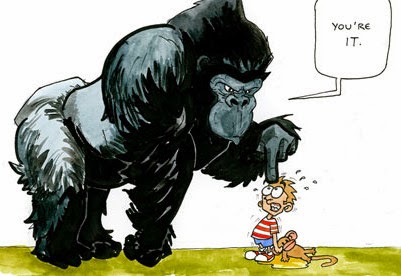Tags may be drawn from any aspect of the character’s appearance or behavior such as:
Voice – The pirate,
Hogshead Shaver, has a voice like a heavy log drawn across gravel and
a limp from an old wound, the pain causing him to be perpetually
cranky. When he appears it is not always necessary to identify him by
name. “As François stood
glaring at the stowaways, he heard a heavy thump of someone climbing
the stairs behind him.” Without saying any more, the reader will
think, “Oh, oh, here comes trouble.”
Physical Features
– Seaman Warden has a weasel face with an Adam’s apple that moves
up and down especially when nervous. Several chapters later, “
François stared at Warden
whose Adam’s apple twitched as he attempted to formulate a lie.”
The reader will automatically say, “Oh, yeah. Weasel face.”
Physical Abilities – Jeremiah
is a mid-teen on his first, real sea voyage. He knows nothing about a
ship, referring to the bowsprit as “That pointy thing on the front
of the boat.” He is faithful, and willing, and proves that his blue
eyes are extra keen which allows him to spend time aloft in the
crow's nest. As he says, “It doesn’t smell like below decks.”
He also has a cast iron stomach to handle the ship's motion.
Dialect or Speech Mannerisms – English soldier, Lt. Harmond, has all the makings of someone Maggie, a woman pirate, would seriously consider sharing a bed with until he opens his mouth and in a snooty, childish-pitch, says, “Humph,” a sound he uses frequently. Toward the end of the story he is not identified by name, but by the use of “Humph,” when speaking, first when among the English conspirators and just before meeting an untimely and unpleasant demise the reader will know who got his just reward.
Hair – Cochran is a blond Irishman with a freckled complexion susceptible to sunburn and wears more clothes than most of the crew, so few are aware of the nasty scar on his left shoulder. He is jovial sort and an inveterate story teller through which he teaches valuable lessons.
Gestures – Seaman Stag swipes his constantly running nose.
Scent – Seaman Filbert
smells as if he'd been bathing in the bilge despite having been
tossed overboard with a bar of soap when the ship was becalmed.
There is an endless laundry list of
quirks and mannerisms available that can become tags and add reality
to your characters, but be careful about using too many for one
character and distracting from the main character. Just one or two
tags, little mnemonic devices to help our readers keep the actors
straight as they pop in and out.
A great place to find ideas is of
course, the movies, specifically looking at the body of work of some
of great character actors such as:
Christopher Lloyd
Johnny Depp
NOTE: This eFile normally appears on the 1st and 15th of the month (or reasonably close), however until mid-September don't be surprised if it is late as much of my writing time is being taken by getting our new home ready to occupy.








